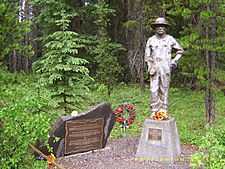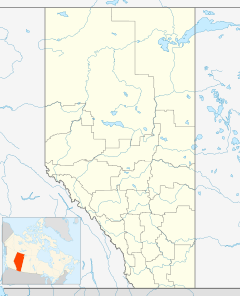Castle Mountain Internment Camp facts for kids
Quick facts for kids Castle Mountain Internment Camp |
|
|---|---|
| Internment camp | |

Monument remembering the camp in Banff National Park, near Castle Mountain. The statue is called Why? in three languages.
|
|
| Coordinates | 51°17′56″N 115°55′19″W / 51.299°N 115.922°W |
| Location | near Castle Mountain, Alberta, Canada |
| Operational | July 13, 1915 – August 1917 |
| Number of inmates | 660 |
The Castle Mountain Internment Camp was a large camp located in Banff National Park, Alberta, Canada. It was the biggest camp of its kind in the Canadian Rockies. During its operation from July 13, 1915, to August 1917, about 660 people were held there.
Contents
What Was Internment?
During World War I, Canada had a law called the War Measures Act. This law allowed the government to hold people who were seen as a threat. These people were called "enemy aliens." Most of them were immigrants from countries Canada was fighting, especially people of Ukrainian, Austrian, Hungarian, and German backgrounds.
Even though these people were civilians and not soldiers, many were sent to camps far from cities. They were made to work on government projects without pay. A lot of this forced labor happened in Canada's national parks. The goal was to build roads and improve facilities for future tourism. By 1915, several camps were open in the Rocky Mountains, including the one at Castle Mountain.
Life and Work at the Camp
The main job for the prisoners at Castle Mountain was to build a highway connecting Banff to Lake Louise. They also built bridges, culverts, and fireguards.
The camp first used tents, but these were not good enough for the cold winter. So, the camp moved to military buildings near the town of Banff, close to the Cave and Basin hot springs. In Banff, the prisoners did many different jobs. They worked on sports fields, cleared land, cut trails, and prepared land for tennis courts, golf courses, and ski jumps. They also crushed rocks and quarried stone for the Banff Springs Hotel and helped with street and sidewalk repairs.
When spring came, the camp moved back to the Castle Mountain site. This moving back and forth happened until August 1917. The camp finally closed then, and the prisoners were allowed to leave and work in industries that needed more workers.
Challenges at the Camp
The Castle Mountain camp was hard to manage. Conditions were tough and unfair for the prisoners. Even though officials in Ottawa knew about these problems, they were not fixed. Many prisoners tried to escape. Other countries and observers raised concerns about how Canada was treating these "enemy aliens." These concerns even reached the War Office in London and were discussed by the British Government and Ottawa.
Remembering the Past
In 2008, an agreement was made with the Ukrainian Canadian community. This agreement was about recognizing and making up for what happened during World War I internment. A big part of this agreement was to provide money for education.
Parks Canada, which manages national parks, is working to create a special center at the Cave and Basin site. This center will teach people about the internment experience. There are also information panels at the site now.
In 1995, a statue was put up near the original Castle Mountain camp-site, off Highway 1a. This statue, made by the Ukrainian Canadian Civil Liberties Association, helps people remember the historical event. In 2012, a leader of the Ukrainian Greek Catholic Church, Sviatoslav, visited the site and held a service to honor those who were held there.
Spreading Awareness
On August 22, 2014, 100 aluminum plaques were put up in 100 different places. These plaques, called "Recalling Canada's First National Internment Operations 1914–1920," showed a photo of prisoners at the Castle Mountain Internment Camp. This project was organized by Dr. Lubomyr Luciuk, a professor at the Royal Military College of Canada.
The year 2014 marked 100 years since Canada's War Measures Act was adopted. This act was used to imprison Ukrainian Canadians and other groups, including people from German, Hungarian, Serbian, Croatian, and Armenian communities. They were sent to one of Canada's 24 World War I internment camps. In 2020, descendants of the prisoners and other members of the Ukrainian-Canadian community held a small ceremony. They marked 25 years since the memorial statue was put in place.



